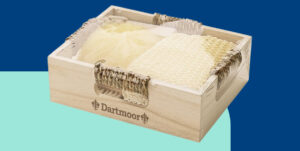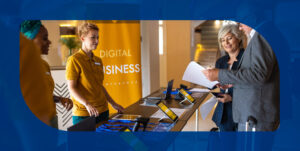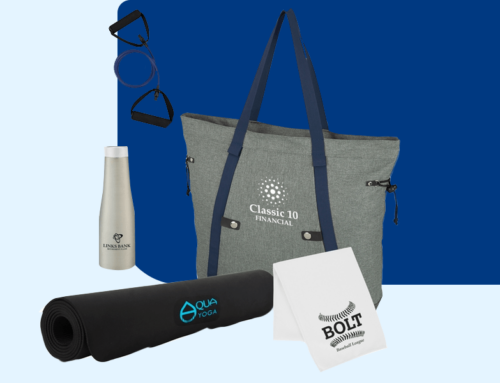05/02/2024
Brand Design 101: A Guide to Developing Your Company’s Brand
Every business wants a brand identity that is instantly recognizable and distinct from any other. Creating a powerful brand takes more than just a logo and color scheme — it requires research, planning and strategy. With the right process, you can develop a memorable brand design that connects with your target audience and increases brand awareness and loyalty.
In this guide, you’ll learn more about branding and the key elements of successful brand design. We’ll guide you through the 10 steps of the brand development process so you can create a strong strategy backed by insights. You’ll also discover how branded promotional products can support brand development and what you should consider before making your own.
What Is a Brand?
To put it simply, a brand is what helps you stand out from similar competitors. When most people think of branding, they picture a logo and company name, but it is so much more than its visual appearance. It’s the identity of your business and the story you tell customers about why you exist and how your products or services can help them. It’s the feelings, opinions and experiences around your business.
A brand grounded by a clear and well-researched strategy helps you differentiate your business, leave a lasting, memorable impression and ultimately encourage people to choose you over others and keep them coming back. It gives employees purpose and provides a roadmap for interacting with customers. Your brand will shape people’s perception of your business and reputation as a whole. Some brands are so strong that people use them to identify a whole category of products — like Band-Aid and Chapstick — or even use them as verbs, like Google.
Brand design refers to the process of developing a brand identity — the image and personality of a brand — in a way that conveys your business’s values and purpose.
The Elements of a Brand
The main elements of a brand are the ones you present to your customers. These include both visual and verbal elements that work together to portray your identity and shape brand perception. Creating these elements is the focus of brand design.

Let’s go over the most common brand elements every business should have and a few branding design examples to help you understand each one:
- Logo: The most important element of a brand is its logo — a graphic representation of its name. Some logos are just the brand name in a stylistic font, while others include artwork and designs to enhance the name. Your logo is what people will associate with your brand, so it’s vital that it represents your brand personality and essence.
- Colors: The color pallet you choose for all your brand design elements will evoke certain emotions and make your brand recognizable. Think of the iconic Coca-Cola red or the gorgeous Tiffany blue. Ensure you choose a cohesive set of colors that supports your brand identity.
- Typography: The fonts and style you choose for your logo and any text in graphical elements also help portray your brand’s personality. From swirling calligraphy to blocky letters, there are thousands of fonts you can use to support your brand’s design. The New York Times — with its interesting old-timey font style — is an excellent example of a brand that uses typography to push its brand identity.
- Imagery: All the images and design elements on your website, advertising and packaging should also reflect your brand and what it stands for. This includes any photos, illustrations, shapes or patterns. Patagonia is one brand that successfully uses imagery to enforce its love of nature and sustainability efforts, which is a large part of its brand.
- Voice: Your brand’s voice is the tone and language you use throughout all messaging, including text and speech. Your brand’s voice is a powerful tool for developing a unique personality that resonates with target audiences. If you use Spotify, you’ll recognize how they use their unique brand voice to appear relatable, trendy and fun to their younger target audience.
- Messaging: Messaging includes any taglines, catchphrases, jingles and slogans that are unique to the business. They should essentially be your entire brand boiled down in a sentence or a few words. Nike’s “Just Do It” is one of the most recognizable taglines.
10 Steps to Develop Your Brand
Before you dive into creating your brand’s identity and design, it’s vital that you craft a solid strategy. A brand strategy is the foundation and guideline for everything brand-related and should be based on thorough research, insights and understanding. Without it, your business will struggle to resonate with its target audience and grow loyalty.
Follow the steps below to develop a sound brand strategy and design that will last years into the future, helping you connect with customers and build a positive reputation.
1. Find Your Purpose
Before you begin with anything, consider why your business exists. If all you can think of is “to make money,” you may want to try again. People don’t buy things just to put money in someone else’s pockets. They make purchases based on their own needs or problems, and this is what your business should tap into. How can you help them?
Research shows that a business’s purpose and values are becoming increasingly important in today’s marketing landscape. Over 80% of consumers want their values to align with the brands they purchase from, and more people are boycotting brands they disagree with.
Find your business’s reason for existing and showcase this to customers to build trust and loyalty.
2. Define Your Brand Objective
Once you know your business’s purpose, it’s helpful to condense it into one single sentence, called a mission statement. This sentence will continually remind you why you do what you do and should guide all business activities, from product design to marketing efforts. Your mission statement covers the who, what and why and outlines your overall business goal.
Most companies begin their mission statements with “to.” As an example, IKEA’s mission statement is “to offer a wide range of well-designed, functional home furnishing products at prices so low that as many people as possible will be able to afford them.” Keep it short and concise, and ensure you can share it externally if needed. You can also create a vision statement outlining your inspiration for the future or the impact you want your business to have on people and the world. For IKEA, this statement is “to create a better everyday life for the many people.”
3. Identify Your Target Audience
The next most essential thing you can do as part of the brand design process is to discover who your ideal customer is. You may think you know them, but have you ever looked deeper into who supports your business? Knowing exactly who your customers are and who you want to reach will help you engage and connect with them.

Observing your current customer demographics is one way to perform market research, but you can also browse social and advertising analytics, look into reviews or send out surveys. Use your experience and any relevant research findings to craft brand personas. These are broad summaries of the different people in your target audience, which cover their demographics, needs, challenges and wants. Refer back to these personas to inform any business or marketing decisions.
4. Research Your Competitors
Branding is all about differentiating your business from others. This is especially important for those with high levels of competition, such as the consumer goods industry. When you offer the same thing as everyone else, you need to find ways to set yourself apart and highlight your benefits to potential customers.
The goal of competitor research is to find out what your competitors are doing that works and what doesn’t. From there, you can improve your offerings or capitalize on your competitor’s weaknesses.
5. Outline Your Brand’s Positioning
Through research, you’ll likely find some key insights that help you understand your business, customers and competition better. With this knowledge in mind, it’s time to create your brand’s positioning statement. This short statement should summarise the main benefit you offer and why customers should choose you. It’s different from your tagline and should be used internally to align communication.
A simple template you can use is: For [your target customer] who [their need or problem], [your business or product] is the [category or product type] that provides [your main benefit] because [the reason to believe].
6. Craft Your Brand’s Personality
The tone and words you use throughout brand communication — no matter how small — create your brand’s personality and shape how customers view your business. Personality is essential to attract and connect with your target market.
Your brand personality should align with your target market research, industry and the identity you want to create. For example, if you cater to younger people, you’ll want to adopt a young, fun and relatable tone. Businesses speaking to corporate professionals will want to appear sophisticated and knowledgeable. Your brand’s personality and voice should appear throughout every interaction with customers.
7. Develop Your Brand Messaging
Along with your brand personality, you’ll want to determine what you should convey in your brand’s messaging or communication efforts. This includes your brand’s tagline — a short, punchy sentence about who your brand is — and the words on your packaging, website and advertisements. The goal of your messaging should be to convey your business’s mission, values and benefits, all in an attempt to convince your target audience to choose you.
Some businesses create a brand story, which covers its history, mission, vision and values in an engaging, narrative way. Rather than listing facts and statements to consumers, you’ll explain who you are through storytelling. You don’t need to write huge paragraphs on your website or create a mini-movie — you can tell your brand’s story across multiple touch points over time or in a short, concise paragraph. Your brand story should create an emotional connection between you and your target audience, so draw on storytelling tactics and impactful language to leave a lasting impression.
8. Create Your Brand’s Visual Elements
Now comes the fun part — creating a visual manifestation of your brand. This is where you can let your creativity flow, using all your research and information from the previous steps as a guideline. Brand designs backed by strategy and planning have a stronger and more powerful effect than those without. This is because each visual element has been chosen with purpose and precision, and together, they all convey one clear message.
Brand visual elements include logos, colors, fonts, images and any other design element that portrays your brand. Ensure each one fits together and aligns with your brand identity for the best results.
9. Outline Brand Touchpoints
Your brand is only helpful if it reaches your target audience in the desired way. To achieve this, consider where they might be and how you can meet them there. These are called brand touchpoints. Some examples include social media, websites, packaging, signage and business cards. Choose each communication platform and vehicle carefully to reach your ideal customer and making sure you’re broadcasting your message to the correct demographic.

10. Communicate Your Brand Consistently
The last step in this process is to communicate your brand the same way across each and every touchpoint. That sounds simple, but with so many marketing platforms and touchpoints, it can be hard to maintain consistent messaging across them all. However, consistency is vital to ensure people have the same experience with your brand and hear the same thing wherever they are.
Using Promotional Products to Develop Your Brand
An incredibly effective tactic businesses use for brand building is promotional products. Promotional products include physical items that showcase your business’s logo and colors, and they’re often given away to people for free. This interaction with potential customers creates a positive perception in their minds — who doesn’t love free gifts? — but they also become familiar with your brand as they use them. When they use these items in public, they’ll help endorse and advertise your brand to others. It’s a win-win scenario!
Consider the following points when choosing promotional products for your business:
- Brand alignment: Carefully select promotional items to match your brand identity and ensure consistency. Handing out something unrelated to your business won’t be as effective as something that is. For example, imagine what would happen when an eco-conscious brand hands out plastic pens — customers will be disappointed at the least. If in doubt, t-shirts are always a safe choice.
- Audience needs: People love receiving gifts they actually need and will use, so think about what your audience may want when selecting your promotional products. Scholars may appreciate notebooks, pens, and stress balls, while sporty people will enjoy branded towels or balls.
- Event relevancy: Consider where you’ll hand out your promotional gifts and try to match them to the occasion. As an example, you could hand out tote bags in the mall or phone chargers and reusable cups at an outdoor event.
- Quality over quantity: Remember that each interaction with your business will affect people’s perceptions. You may think buying lots of cheap, low-quality items will get the job done and save money, but it can harm your reputation when they break or don’t function well. Choose high-quality promotional items that are useful and appealing for the best results.
Buy Branded Promotional Products from ePromos
Increasing brand awareness and loyalty is easy through promotional products if you consistently align your choices with your brand identity and values. At ePromos, we understand the importance of consistent branding, which is why we don’t just sell promotional products — we offer a full-service solution to make your promotions a success. From artwork services to gift packaging and online merchandise stores, our team of talented designers and branding experts can make your promotional products look their best.
We’ll guide you through the whole process, from concept to delivery. We offer a 110% satisfaction guarantee and accuracy promise with all our orders. We want you to be genuinely happy with your products, so of the imprint is wrong or the ship date isn’t met, your orderis free! Take a look at some of our glowing testimonials to see how we’ve helped other businesses build their brands.
Browse our wide range of promotional products today and call 877-377-6667 to speak with an expert. We look forward to bringing your promotional ideas to life!







